 |
Let Me Show You What HDR Photography Is All About And The Techniques Used For Producing High Dynamic Range Photos
|
|
HDR photography is the common term for images with a range of detail not normally possible with ordinary photographs.
The acronym HDR stands for High Dynamic Range, a phrase borrowed from the specialist field of technical imaging, and now applied to a set of techniques designed to overcome the key limitation of photographic film and digital image sensors - their narrow sensitivity to light compared to the images perceived by our eyes and brain.
In recent years HDR photography has grown from an obscure art into a mainstream style. New software techniques and the boom in the use of digital cameras have combined to create an often distinctive class of photographic image that is now widespread in magazines, advertising, online media, and even many Hollywood movies.
HDR photography manipulations can be subtle, to improve the details in a photograph without creating an unnatural effect - or they can be exaggerated, to create images with almost impossible levels of detail that can appear dreamlike, cartoon-like or surreal.
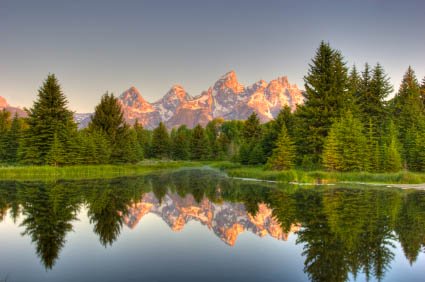 |
When imaging specialists talk about High Dynamic Range, they mean something different than the common use of the term today. True HDR images are captured with specialist HDR cameras that record the light level of each pixel with very fine accuracy, resulting in an image that can closely represent the true luminance of each part of the scene.
In real life the ratio of luminance between the darkest part of a scene and the brightest part can be as much as 100,000:1.
The human visual system can resolve ratios as high as 16,000:1, but only thanks to some very clever tricks performed by eyes and the brain.
Specialised HDR cameras, and some types of transparency film, can capture scenes with ratios as high as 5000:1 or more. But the sensors on a good digital camera will usually give a dynamic range of only between 1000:1 and 2000:1.
Why Is What The Eye Sees Different To What The Camera Sees?
The differences between what the eye sees and what a camera sees are familiar to most photographers - a portrait shot taken in bright sunlight might look okay through the viewfinder, but produce a photograph spoiled by being either too dark in the shadows or too bright in the light.The problem is also common in landscape photography, where the dynamic range between the sky and the landscape can be very high. A photographer has to choose the exposure to capture the detail of either the sky or the landscape - or compromise, and lose detail in both.
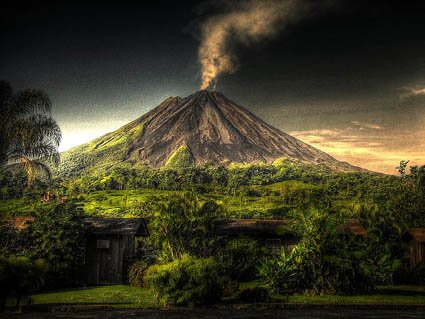 |
| Arenal Volcano, Costa
Rica By Isaac Bordas, Creative Commons License |
An image in the human visual system is created by the brain from a series of "samples" recorded by the eyes, which move rapidly and unconsciously when looking at any scene.
As the eyes view different parts of a scene they can quickly adjust to different light levels by varying the aperture of the pupil. The brain is continually processing samples from the eyes into a composite visual map of a scene, which is perceived as a detailed image with a high dynamic range.
Photographs, on the other hand, are usually only exposed once, and often a photographer faces the choice of exposing the shot to capture the bright highlights of a scene and losing detail in the shadows, or exposing for the shadows and blowing out the highlights.
Modern cameras with through-the-lens (TTL) exposure meters have different ways of calculating a sweet spot for the exposure of a photograph, but the problem remains: a camera can only resolve a fraction of the dynamic range resolved by the human visual system.
The common methods of reproducing photographs create further problems - the dynamic range of an LCD screen, or the paper used to print digital photographs, is about half that of a digital camera.
Techniques of HDR photography
HDR photography techniques aim to bridge the gap between what the eye sees and what the camera sees.There are several ways of achieving this, but the most common way is to use the data from several digital exposures to make a single photograph with the widest possible range of visual detail.
This is a rough approximation of how the eyes and brain create the perception of high-dynamic range - capturing detail at different exposures, and then combining the details into a single composite image.
Film photographers have long used HDR-like techniques to improve their images. Split neutral density filters can be used to darken the sky in landscape shots, and darkroom techniques such as burning and dodging can manipulate the exposure of printed photographs.
In the 1850s the pioneering French photographer Gustave Le Gray first used multiple exposures to create images of seascapes - using one negative for the sky, and another with a longer exposure for the sea, and combining the two negatives to make a single photograph in positive.
Thanks to modern digital cameras and imaging software the process of combining several images is now relatively straightforward. Many photo-editing applications and some cameras have functions to aid the creation of HDR photographs, which has fostered the current popularity of HDR images among amateur and professional photographers.
Because these images are taken with standard cameras and usually reproduced on a computer screen or printed paper, they are not "true" HDR images: technically they are Low or Standard dynamic range (LDR and SDR) with an idealised distribution of the lighting range across the image, giving the appearance of greater range.
But the term HDR has now stuck fast to this type of photography - and especially to the sort of brightly coloured, highly-detailed landscapes and cityscapes beloved by many digital HDR photographers.
 |
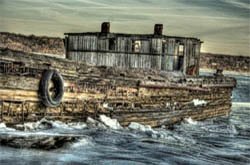 |
| Wooden
boat on the
Hudson River, New York state, USA By Andy Milford, Creative Commons License |
|
The two images above illustrate the effect of combining multiple exposures.
The image on the left is the result of one mid-range exposure of the scene, and the image on the right is an HDR composite of three exposures of the same scene, taken with different aperture openings or shutter speed to vary the duration of the exposures.
For this method it is common to make three exposures of every scene: a mid-range exposure, an exposure one or two stops higher the first, and an exposure one or two stops lower than the first.
The HDR photograph on the right shows more visible detail than the single mid-range exposure: the old wood of the boat appears bright and distinct in the HDR, and the trees and buildings of the shoreline show a greater range of contrasting detail.
Many digital SLR cameras have a bracketing function that can be set to change the exposure automatically for each shot of the same scene, and it is also possible to combine more than three exposures into a single HDR photograph.
It is important that the framing for each exposure should be identical, although cropping and "stitching" with photo editing software can fix small differences. Using a tripod for the camera is practically essential, and using a shutter remote is ideal.
Post-processing HDR Photographs
The multiple exposures are merged into a single HDR file using either photo-processing software, or sometimes using software within the camera itself.Adobe Photoshop versions after CS2 have a merge to HDR function, and there are also specialist HDR editing applications available, such as Photomatix Pro
A software technique called tone mapping is then used on the merged file to combine the light and dark details into a single photograph to produce the effect of a high range of detail and colour. Tone-mapping can also be used to manipulate the colours of a single exposure, to produce images with exaggerated local contrast for artistic effect.
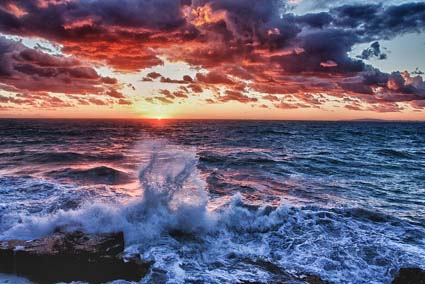 |
| Majorca, Spain By Andrés Nieto Porras, Creative Commons License |
This is usually the method used in compact cameras and smart phones that have an HDR mode, but it is also effective with digital SLRs that shoot images in RAW format, which can be used to create various exposures of a single shot.
This method avoids artefacts that can appear when different exposures are combined, such as those caused by JPEG compression, camera shake, or objects moving in the frame between shots.
Tone mapping reduces the dynamic range of the entire image, but keeps the localised contrast between neighbouring pixels - exploiting features of the human visual system to create an image that represents a wide dynamic range, but which can be reproduced on common LDR media like an computer screen or photographic print.
Tone mapping is perhaps more of an art than a science, and here HDR photographers love to experiment.
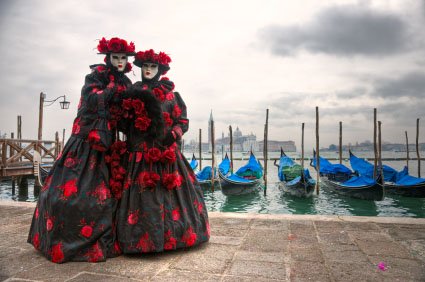 |
Many prefer a traditional look that maximises the detail in a photograph while retaining realistic colour and contrast, but others use tone mapping to create striking or surreal images that may look distinctly different from the original scene - depending on their taste, photographic style, and experience.
Learn More About HDR Photography
One of the best ways to learn about HDR photography is by watching a HDR video tutorial. Trey Ratcliff from StuckInCustoms.com is an expert in HDR photography and has produced the best collection of videos on this topic to date. Around 11 hours of lessons and instruction.As part of his in-depth course you'll learn about creative and innovative post-processing techniques. You also get around 130 RAW images to experiment with while watching the videos.
Other areas that are covered are:
- Settings For Taking HDR Photos
- Post Processing Your Files Including Layers
- Using Photoshop, Photomatix and Silver Efex Pro
- Composition And Lens Choices
| Didn't find what you're looking for? Search here... |

Custom Search
|
Return from HDR Photography to Digital Photography Tricks





